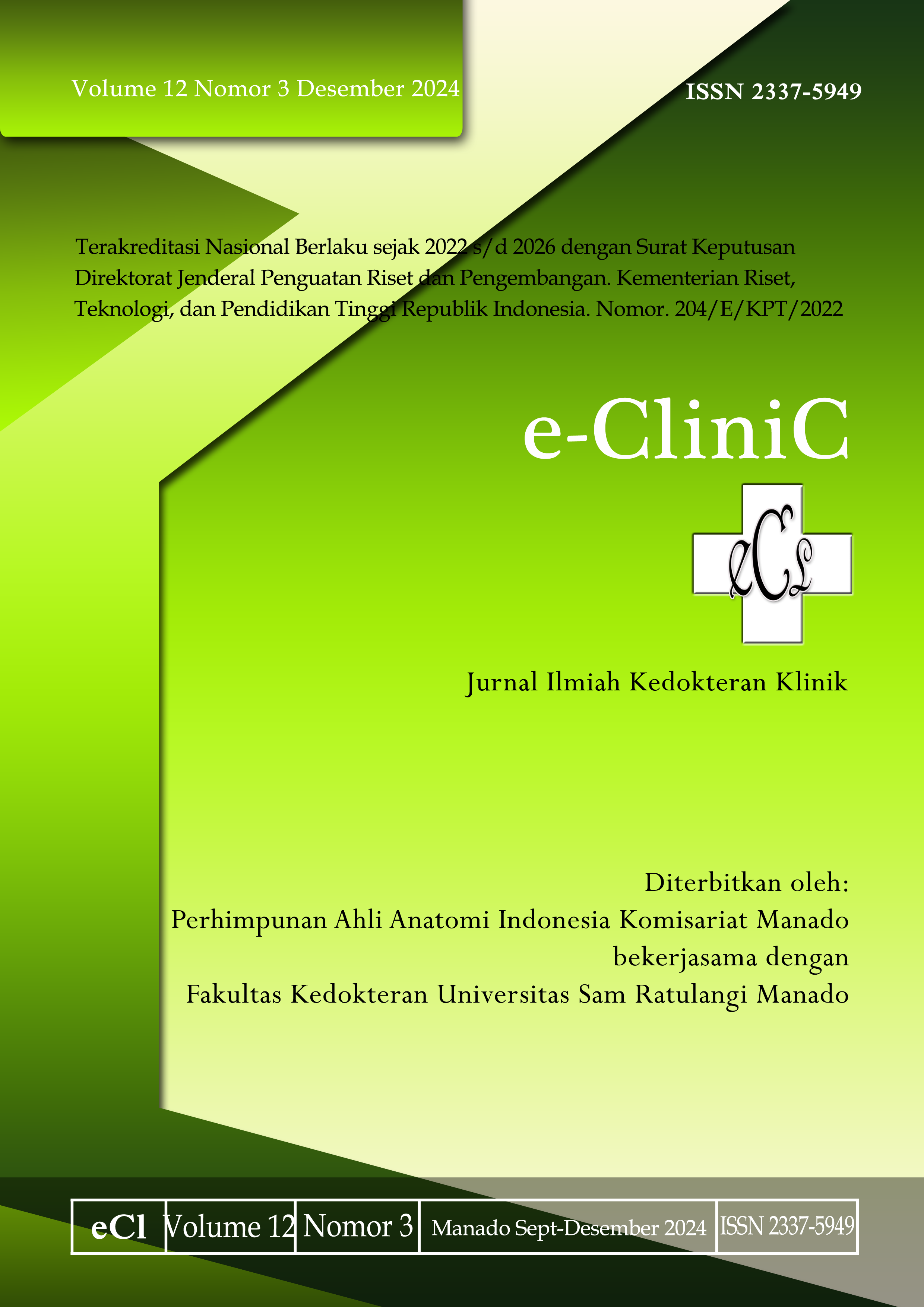Profil pasien refluks laringofaring di RSUP Prof. Dr. R. D. Kandou Manado
DOI:
https://doi.org/10.35790/ecl.v12i3.53653Abstract
Abstract: Diagnosis of laryngopharyngeal reflux (LPR) requires a clinical history based on clinical symptoms (Reflux Symptom Index - RSI) and laryngeal examination (Reflux Finding Score - RFS) due to its nonspecific symptoms and laryngoscopic signs do not always correlate with the severity of symptoms. This study aimed to obtain the profile of patients with LPR at Prof. Dr. R. D. Kandou Hospital. This was a retrospective and descriptive study using medical records of LPR patients at Prof. Dr. R. D. Kandou Hospital during the period 2020-2022. The results showed that the majority of LPR patients were females (57.6%), aged 41-65 years and occupation as housewife. The most commonly experienced complaints were difficulty in swallowing (36.3%) and feeling of throat tightness (25,0%). The most frequent endoscopic finding was erythema/hyperemia of the arytenoids (36.8%). In conclusion, laryngo-pharyngeal reflux is often experienced by females aged 41-65 years, occupation as housewife. The most common complaints are difficulty in swallowing and feeling of throat tightness. Erythema/hyperemia of the arytenoid has the highest percentage in endoscopic finding.
Keywords: laryngopharyngeal reflux; patient profile
Abstrak: Dalam mendiagnosis refluks laring faring (RLF), diperlukan anamnesis berdasarkan gejala klinis (Reflux Symptom Index - RSI) dan pemeriksaan laring (Reflux Finding Score - RFS) karena gejalanya tidak spesifik dan tanda laringoskopi tidak selalu sesuai dengan tingkat keparahan gejala. Penelitian ini bertujuan untuk mendapatkan profil pasien RLF di RSUP Prof. Dr. R. D. Kandou Manado. Jenis penelitian ialah deskriptif retrospektif menggunakan data pasien yang tercatat di Instalasi Rekam Medis RSUP Prof. Dr. R.D. Kandou Manado periode 2020 hingga 2022. Hasil penelitian mendapatkan bahwa mayoritas pasien RLF ialah perempuan (57,6%) dengan usia 41-65 tahun. Distribusi pekerjaan menunjukkan jumlah pasien tertinggi ialah ibu rumah tangga. Keluhan yang paling sering dialami ialah sulit menelan (36,3%) dan rasa mengganjal pada leher (25,0%). Temuan endoskopi paling sering ialah eritema/hiperemis aritenoid (36,8%). Simpulan penelitian ini ialah refluks laring faring sering dialami oleh perempuan pada usia 41-65 tahun, dengan pekerjaan sebagai ibu rumah tangga. Keluhan paling sering ialah sulit menelan dan rasa mengganjal di tenggorokan. Distribusi tertinggi pasien refluks laring faring berdasarkan kondisi laring ialah eritema/hiperemis aritenoid.
Kata kunci: refluks laringofaring; profil pasien
References
Widiantari IAA, Sucipta IW. Karakteristik penderita laryngopharyngeal reflux yang didiagnosis berdasarkan reflux symptom index dan reflux finding score di poliklinik THT-KL RSUP Sanglah tahun 2015-2017. Medicina (B Aires). 2019;50(3):457–61. Doi: https://doi.org/10.15562/medicina.v50i3.678
Yunizaf M, Iskandar N. Penyakit refluks gastroesofagus dengan manifestasi otolaringologi. In: Telinga, Hidung, Tenggorok, Kepala & Leher: Buku Ajar Ilmu Kesehatan (7th ed). Jakarta: Badan Penerbit Fakultas Kedokteran Universitas Indonesia; 2015. p. 270–3. Available from: https://lib.ui.ac.id/detail?id=20417489
Lechien J, Akst L, Hamdan A, Schindler A, Karkos P, Barillari M, et al. Evaluation and management of laryngopharyngeal reflux disease: state of the art review. Otolaryngol Head Neck Surg. 2019;160(5): 762–82. Doi: 10.1177/0194599819827488
Massawe WA, Nkya A, Abraham ZS, Babu KM, Moshi N, Kahinga AA, et al. Laryngopharyngeal reflux disease, prevalence and clinical characteristics in ENT department of a tertiary hospital Tanzania. World J Otorhinolaryngol Head Neck Surg. 2021;7(1):28–33. Doi: 10.1016/j.wjorl.2020.04.009
Lechien JR, Saussez S, Muls V, Barillari MR, Chiesa-Estomba CM, Hans S, et al. Laryngopharyngeal reflux: a state-of-the-art algorithm management for primary care physicians. Journal of Clinical Medicine. 2020;9(11):1–18. Doi: 10.3390/jcm9113618
Perdana RF, Rusuldi RC, Thamrin H, Falerina R. Characteristics of laryngopharyngeal reflux: a retrospective descriptive study. Qanun Medika. 2022;6(2):209-19. Doi: https://doi.org/10.30651/jqm.v6i2.11647
Binti Sa’an N, Asyari A, Fitri F. Gambaran pasien laryngopharyngeal reflux di bagian poliklinik THT-KL RSUP Dr. M. Djamil Padang periode 2017. Jurnal Ilmu Kesehatan Indonesia. 2020;1(2). Available from: http://jikesi.fk.unand.ac.id43
Mishra P, Agrawal D, Chauhan K, Kaushik M. Prevalence of laryngopharyngeal reflux disease in Indian population. Indian J Otolaryngol Head Neck Surg. 2022;74(Suppl 2):1877–81. Doi: 10.1007/s12070-020-01882-1
Munifah AP, Perdana RF, Juniati SH, Yusuf M, Dewi ER. The profile of laryngopharyngeal reflux patients at Dr. Soetomo Teaching Hospital, Surabaya Indonesia. Indian Journal of Forensic Medicine & Toxicology. 2020;14(4):4160-66. Doi: https://doi.org/10.37506/ijfmt.v14i4.12293
Ricci G, Wolf AE, Barbosa AP, Moreti F, Gielow I, Behlau M. Signs and symptoms of laryngopharyngeal reflux and its relation to complaints and vocal quality. Codas. 2020;32(5):e20180052. Doi: 10.1590/2317-1782/20202018052
Saraswati PA, Suyasa IGPD, Wulandari IA. Hubungan tingkat stres dengan gejala gastritis mahasiswa tingkat IV. Jurnal Gema Keperawatan. 2022;15(2):207–16. Doi: https://doi.org/10.33992/jgk.v15i2.2021
Lechien JR, Saussez S, Karkos PD. Laryngopharyngeal reflux disease: clinical presentation, diagnosis and therapeutic challenges in 2018. Curr Opin Otolaryngol Head Neck Surg. 2018;26(6):392–402. Doi: 10.1097/MOO.0000000000000486
Putri SEE, Yusmawan W, Yunika K. Perbedaan skor RSI penderita laryngopharyngeal reflux yang mendapat omeprazole dan lansoprazole. Jurnal Kedokteran Diponegoro. 2018;7(1):348-58. Doi: https://doi.org/ 10.14710/dmj.v7i1.19393
Downloads
Published
How to Cite
Issue
Section
License
Copyright (c) 2024 Maureen Runtung, Olivia C. P. Pelealu , Valentini M. Pontoh

This work is licensed under a Creative Commons Attribution-NonCommercial 4.0 International License.
COPYRIGHT
Authors who publish with this journal agree to the following terms:
Authors hold their copyright and grant this journal the privilege of first publication, with the work simultaneously licensed under a Creative Commons Attribution License that permits others to impart the work with an acknowledgment of the work's origin and initial publication by this journal.
Authors can enter into separate or additional contractual arrangements for the non-exclusive distribution of the journal's published version of the work (for example, post it to an institutional repository or publish it in a book), with an acknowledgment of its underlying publication in this journal.
Authors are permitted and encouraged to post their work online (for example, in institutional repositories or on their website) as it can lead to productive exchanges, as well as earlier and greater citation of the published work (See The Effect of Open Access).







